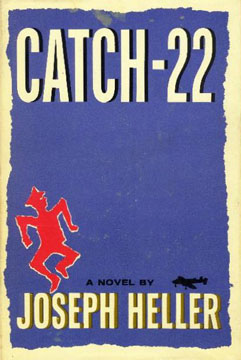Catch-22 Review

November 5, 2014
Catch-22, a satirical novel written by the late Joseph Heller, was first published in 1961. The novel takes place between 1942 and 1944, and focuses on an American bombardier squadron stationed on the fictional island of Pianosa (which is west of Italy) and their struggle to maintain sanity in the midst of war. You may have heard of this novel before, or the popular phrase which is derived from its title. Catch-22 has received mostly positive reviews in the decades since its initial release and is considered one of the greatest literary works of the past century. There are many reasons as to why this novel is considered to be a great work of literature. One of which is the non-linear, third-person narration. Another is the satire of McCarthyism, American business, and most notably, bureaucracy. The beauty of what Heller does, however, is not a bland representation of any of these things. Through the outrageous antics of the novel’s characters and the seriousness of the horrors of war, Heller gives a new meaning to “satire” and “war” novels.
Now you may have a basic grasp of what this book is about, so what’s the catch then? In Catch-22 there is only one catch, which is, you guessed it, catch-22. Catch-22 states that someone is sane if they are in the face of danger and concerned for their own safety. For the members of the squadron, this means that they can be “grounded” and won’t have to fly anymore. However, only crazy people can be deemed unfit to fly. So, since anyone who wishes to stop flying is deemed sane, they cannot be grounded because they are clearly in their right minds. This simple rule manifests the ridiculous (but oddly reasonable) reasoning of a bureaucratic system. The absurdity of catch-22 and of many other rules presented throughout the novel is a trademark characteristic of Heller’s classic.
Perhaps the most confusing aspect of Catch-22 is how it is told. The novel is narrated from an omniscient, third-person perspective. But the kicker is the non-linear story-line; most of the novel is not told in chronological order. Honestly, it did throw me off a bit when I was in the middle of the novel and Heller would talk about this event which happened at this time and then in the next chapter jump to a flashback that was unrelated to the previous chapter. But, as Heller so intriguingly does, the non-linear story-line ultimately forms a clear image of who is who and what is going on. And for the last several chapters of the novel, the narrative gradually becomes completely chronological right into the ending.
Since Catch-22 is generally defined as a great “satire” novel, Heller manages to pull off the satirical aspect quite well. Without disclosing specific details, Heller satirizes the general absurdity of various topics, some of which were previously mentioned. The perception of appearance and reality is one example. This essentially means that whatever body of power is in charge can declare something reality based on its appearance (particularly if it is on paper) instead of what it is in reality. A separate example, and by far the most notable point of satire in all of Catch-22 is bureaucracy. The sheer absurdity in what a particular system does (in the novel’s case, the military) and can do is brought up throughout the novel.
This novel is without a doubt exceptional. Rarely is there a book which can cause you to laugh and deliver a clear message. Not to mention the redefining of what you’d typically call “satire”. Also, the vivid description of characters and the utter hilarity of their traits is something not many authors can do well with. Considering all of this, there are few faults to be found in Heller’s Catch-22. The only perceptible fault would be the confusion experienced due to the odd narration style. Regardless, that fault in itself has positive qualities to it. To you, the reader, I certainly recommend Catch-22 as it is a wonderful work of satire and a unique take on war which you cannot find anywhere else.